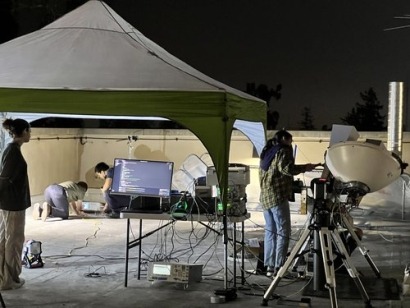
Wireless power transfer was demonstrated by MAPLE, one of three key technologies being tested by the Space Solar Power Demonstrator (SSPD-1), the first space-borne prototype from Caltech's Space Solar Power Project (SSPP). SSPP aims to harvest solar power in space and transmit it to the Earth's surface.
MAPLE, short for Microwave Array for Power-transfer Low-orbit Experiment and one of the three key experiments within SSPD-1, consists of an array of flexible lightweight microwave power transmitters driven by custom electronic chips that were built using low-cost silicon technologies. It uses the array of transmitters to beam the energy to desired locations. For SSPP to be feasible, energy transmission arrays will need to be lightweight to minimize the amount of fuel needed to send them to space, flexible so they can fold up into a package that can be transported in a rocket, and a low-cost technology overall.
MAPLE was developed by a Caltech team led by Ali Hajimiri, Bren Professor of Electrical Engineering and Medical Engineering and co-director of SSPP.
"Through the experiments we have run so far, we received confirmation that MAPLE can transmit power successfully to receivers in space," Hajimiri says. "We have also been able to program the array to direct its energy toward Earth, which we detected here at Caltech. We had, of course, tested it on Earth, but now we know that it can survive the trip to space and operate there."
Using constructive and destructive interference between individual transmitters, a bank of power transmitters is able to shift the focus and direction of the energy it beams out—without any moving parts. The transmitter array uses precise timing-control elements to dynamically focus the power selectively on the desired location using the coherent addition of electromagnetic waves. This enables the majority of the energy to be transmitted to the desired location and nowhere else.
MAPLE features two separate receiver arrays located about a foot away from the transmitter to receive the energy, convert it to direct current (DC) electricity, and use it to light up a pair of LEDs to demonstrate the full sequence of wireless energy transmission at a distance in space. MAPLE tested this in space by lighting up each LED individually and shifting back and forth between them. The experiment is not sealed, so it is subject to the harsh environment of space, including the wide temperature swings and solar radiation that will be faced one day by large-scale SSPP units.
"To the best of our knowledge, no one has ever demonstrated wireless energy transfer in space even with expensive rigid structures. We are doing it with flexible lightweight structures and with our own integrated circuits. This is a first," says Hajimiri.
MAPLE also includes a small window through which the array can beam the energy. This transmitted energy was detected by a receiver on the roof of the Gordon and Betty Moore Laboratory of Engineering on Caltech's campus in Pasadena. The received signal appeared at the expected time and frequency, and had the right frequency shift as predicted based on its travel from orbit.
Space solar power provides a way to tap into the practically unlimited supply of solar energy in outer space, where the energy is constantly available without being subjected to the cycles of day and night, seasons, and cloud cover—potentially yielding eight times more power than solar panels at any location on Earth's surface. When fully realized, SSPP will deploy a constellation of modular spacecraft that collect sunlight, transform it into electricity, then convert it to microwaves that will be transmitted wirelessly over long distances to wherever it is needed—including locations that currently have no access to reliable power.
"The flexible power transmission arrays are essential to the current design of Caltech's vision for a constellation of sail-like solar panels that unfurl once they reach orbit," says Sergio Pellegrino, Joyce and Kent Kresa Professor of Aerospace and Civil Engineering and co-director of SSPP.
"In the same way that the internet democratized access to information, we hope that wireless energy transfer democratizes access to energy," Hajimiri says. "No energy transmission infrastructure will be needed on the ground to receive this power. That means we can send energy to remote regions and areas devastated by war or natural disaster."
SSPP got its start in 2011 after philanthropist Donald Bren, chairman of Irvine Company and a lifetime member of the Caltech Board of Trustees, first learned about the potential for space-based solar energy manufacturing as a young man in an article in the magazine Popular Science. Intrigued by the potential for space solar power, in 2011, Bren approached Caltech's then-president Jean-Lou Chameau to discuss the creation of a space-based solar power research project. In the years to follow, Bren and his wife, Brigitte Bren, also a Caltech trustee, agreed to make the donation to fund the project. The first of the donations to Caltech (which will eventually exceed $100 million in support for the project and endowed professorships) was made through the Donald Bren Foundation.
"The hard work and dedication of the brilliant scientists at Caltech have advanced our dream of providing the world with abundant, reliable and affordable power for the benefit of all humankind," Bren says.
"Demonstration of wireless power transfer in space using lightweight structures is an important step toward space solar power and broad access to it globally," says Harry Atwater, Otis Booth Leadership Chair of Division of Engineering and Applied Science; Howard Hughes Professor of Applied Physics and Materials Science; Director of the Liquid Sunlight Alliance; and one of the principal investigators of the project. "Solar panels already are used in space to power the International Space Station, for example, but to launch and deploy large enough arrays to provide power to Earth, SSPP has to design and create solar power energy transfer systems that are ultra-lightweight, cheap, and flexible."
Inflormation provided by CalTech

